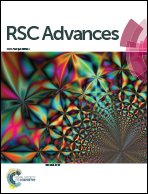Coupling with a narrow-band-gap semiconductor for enhancement of visible-light photocatalytic activity: preparation of Bi2S3/g-C3N4 and application for degradation of RhB†
Abstract
A coupled system for the photodegradation of Rhodamine B dye was realized using a Bi2S3/g-C3N4 composite as a photocatalyst under visible light irradiation. The Bi2S3/g-C3N4 composite was prepared by a hydrothermal method and characterized by Fourier transform-infrared spectroscopy (FT-IR), X-ray diffraction (XRD), UV-vis diffuse reflectance spectroscopy (DRS), scanning electron microscopy (SEM) and transmission electron microscopy (TEM). Compared with pure g-C3N4, the Bi2S3/g-C3N4 sample exhibits an enhanced photocatalytic activity and the best photocatalytic efficiency is 3.68 times more than that of pure g-C3N4. The obtained results indicate that a coupled system of Bi2S3 and g-C3N4 could overcome the drawback of low photocatalytic efficiency brought by electron–hole recombination and a narrow photoresponse range. On the basis of the corresponding energy band positions, the mechanism of photocatalytic activity enhancement was proposed.


 Please wait while we load your content...
Please wait while we load your content...